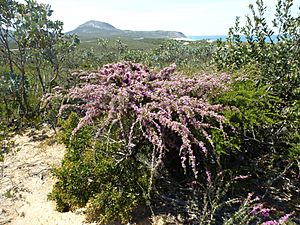Melaleuca scabra facts for kids
Quick facts for kids Rough honey-myrtle |
|
|---|---|
 |
|
| M. scabra growing at Mylies Beach near East Mount Barren | |
| Scientific classification | |
| Genus: |
Melaleuca
|
| Species: |
scabra
|
| Synonyms | |
|
|
The Melaleuca scabra, also known as the rough honey-myrtle, is a type of shrub. It grows only in a small part of Western Australia's south coast. This plant has bumpy, "warty" leaves. It produces many beautiful pink to purple flowers. These flowers bloom between July and November.
Contents
About the Rough Honey-Myrtle Plant
The rough honey-myrtle is a shrub. It usually grows to be about 1.2 meters (4 feet) tall and wide. Its branches, twigs, and leaves are smooth, meaning they don't have hairs.
What Do the Leaves Look Like?
The leaves of this plant grow in an alternating pattern along the stem. They are long and narrow, or sometimes a bit oval-shaped. The leaves are "warty," meaning they have small bumps on them. Each leaf is about 5 to 21 millimeters (0.2 to 0.8 inches) long. They are only about 1 millimeter (0.04 inches) wide. Often, there is a small groove or channel on the underside of the leaf.
How Does the Rough Honey-Myrtle Flower?
The flowers grow in clusters at the ends of the branches. Even after the plant flowers, these branches keep growing. Each flower cluster can be up to 22 millimeters (0.9 inches) wide. Inside each cluster, there are up to five smaller groups of flowers. Each of these smaller groups has three individual flowers.
The parts of the flower that produce pollen are called stamens. These stamens are usually pink or deep purple. They have a yellow tip called an anther. The stamens are arranged in five groups around the flower. Each group contains between three and six stamens.
When Does It Flower and Produce Fruit?
The rough honey-myrtle blooms from July to November. After flowering, the plant produces fruit. The fruit is a hard, woody capsule. Each capsule is about 3 to 4 millimeters (0.1 to 0.2 inches) long. These capsules grow in round clusters on the plant.
Naming the Rough Honey-Myrtle
The scientific name for this plant, Melaleuca scabra, was first officially described in 1812. This was done by a botanist named Robert Brown. He wrote about it in a book called Hortus Kewensis.
What Does "Scabra" Mean?
The second part of the plant's name, scabra, comes from a Latin word. The word scaber means "rough" or "bumpy." This name perfectly describes the plant's warty leaves.
For a long time, people thought this type of melaleuca plant was found in many places. But in 1999, two botanists, Lyndley Craven and Brendan Lepschi, studied the genus again. They found that Melaleuca scabra actually grows in a much smaller area.
In 1828, another botanist named Robert Sweet wrote about this plant. He called it "a rare and beautiful plant." He also said its flowers were "dark purple and produced in great abundance." He noted that the flowers were "crowded in dense heads" and had "a pleasant aromatic scent."
Where the Rough Honey-Myrtle Grows
The rough honey-myrtle is found along the coast of Western Australia. It grows in areas between Hopetoun and Israelite Bay. These areas are part of the Esperance Plains and Mallee regions. The plant can grow in different types of soil, including sand, clay, or laterite.
Conservation Status
The Government of Western Australia's Department of Parks and Wildlife has looked at the rough honey-myrtle. They have classified it as "not threatened." This means the plant is not currently at risk of disappearing.
Images for kids
-
This image shows the rough honey-myrtle growing in its natural home at Mylies Beach, near East Mount Barren.





